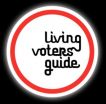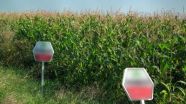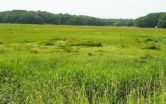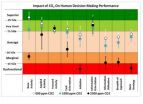(Press-News.org) When facing a difficult choice, many of us turn to that old standby: the pro-con list. A University of Washington project takes election pro-con lists to the next level, moving them online and allowing voters to work together to draft points – brief arguments for or against – and refine their positions.
Now in its third year, the Living Voters Guide, presented in partnership with Seattle's CityClub, just won a regional award and has been updated for the 2012 election. This year the guide has expanded to include a California edition, and the Washington guide will include fact-checking of selected points by Seattle Public Library staff.
UW researchers in computer science and communications developed the tool.
"We wanted to create a way to use the Internet to listen to other people in a constructive way," said Travis Kriplean, a postdoctoral researcher in computer science and engineering who implemented the guide as part of his UW doctoral thesis.
Users' feedback in previous years has been positive, Kriplean reported. "People have said: 'We can listen to what the other side is saying and find some common ground. I didn't know that could happen.'"
To use the Living Voters Guide, go to the site, create an account and choose one of the eight Washington ballot measures. Then you can read through short arguments put forward by other users, or add your own. Choose the best points for and against each measure and save your list. Emails will tell you when other people comment on your picks.
Over time, more popular points are moved up the list, to offer new users the most persuasive arguments for and against each issue.
This year's gay marriage debate may not offer much common ground, Kriplean admitted, but others, like charter schools, are likely to spark discussion among voters trying to better understand the issue and come to a decision.
In previous years, some users reported not knowing which points to trust, said Alan Borning, professor of computer science and engineering and Kriplean's doctoral adviser. For instance, a point might claim that approving or rejecting the measure would cost the state millions of dollars in revenue.
Starting this week the Seattle Public Library will verify the content of flagged claims and post fact-checking results, with citations, within 48 hours.
"We want to do it in a way that's not confrontational," Kriplean said. "But at the same time we want to be able to provide people with signals as to what's believable."
In 2010 about 10,000 people used the tool, Kriplean said, and last year it got about twice as many users despite there being no state or federal elections.
In the expansion to a California edition, the team is working with the University of Southern California and the University of California, Berkeley to promote the site with funding from the Whitman Institute. California's active civic groups, large population and contentious ballot measures make it an obvious place to expand, Kriplean said.
People can also use the site to explore top points on each measure or look at results from previous elections. A team of graduate students led by Lance Bennett, a UW professor of political science and communication, helped design the guide and will use the data to analyze its effectiveness. The research portion of the project is funded by the National Science Foundation and a Google Research Award.
In both states the team will advertise the tool through nonprofit and civic organizations, and with Google ads that appear when people search online for ballot measures. In Washington the researchers are working with civic organization CityClub to promote the project and advertise on buses and billboards, hoping to attract users from across the political spectrum.
Living Voters Guide recently won the inaugural Evergreen Apps Challenge, a contest co-sponsored by the state, King County and the City of Seattle to use government resources to benefit local citizens. Kriplean now plans to launch a startup that would help government agencies, nonprofits and even companies promote civil online debate on thorny issues.
"As a research project it's been successfully incubated in the university, and we're going to try to take it out, stabilize it and make it more of a product," Kriplean said.
INFORMATION:
For more information, contact Kriplean at travis@cs.washington.edu or 206-291-8331.
City Club contact: Bridget Anderson at 206-682-7395 or banderson@seattlecityclub.org.
Seattle Public Libraries contact: Andra Addison at 206-386-4103 or andra.addison@spl.org.
Living Voters Guide adds fact-checking by Seattle librarians for 2012 election
2012-10-18
ELSE PRESS RELEASES FROM THIS DATE:
A European-wide network for systematic GMO impact assessment
2012-10-18
In Europe there are many concerns about adverse environmental effects of GM crops, and the opinions on the outcomes of environmental risk assessments (ERA) differ largely. GM crop safety testing and introduction studies among the regulatory system are insufficiently developed. Therefore the proposed framework aims at improving the regulatory system.
Specific elements of the network are a) methodologies for both indicator and field site selection for GM crop ERA and PMEM, b) an EU-wide typology of agro-environments, c) a pan-European field testing network using GM crops, ...
Keck observations bring weather of Uranus into sharp focus
2012-10-18
MADISON – In 1986, when Voyager swept past Uranus, the probe's portraits of the planet were "notoriously bland," disappointing scientists, yielding few new details of the planet and its atmosphere, and giving it a reputation as a bore of the solar system.
Now, however, thanks to a new technique applied at the Keck Observatory, Uranus is coming into sharp focus through high-resolution infrared images, revealing in incredible detail the bizarre weather of the seventh planet from the sun.
The images were released in Reno, Nev. today (Oct. 17, 2012) at a meeting of the ...
U of M scientist contributes to mapping of barley genome
2012-10-18
MINNEAPOLIS / ST. PAUL (10/17/2012) —An international team of researchers, including a University of Minnesota scientist, has developed an integrated physical, genetic and functional sequence assembly of the barley genome, one of the world's most important and genetically complex cereal crops. Results are published in today's issue of Nature.
The advance will give researchers the tools to produce higher yields, improve pest and disease resistance, and enhance the nutritional value of barley.
Importantly, it also will "accelerate breeding improvements to help barley ...
Gluten and lactose-free ingredient substitute found for low-fat white sauces
2012-10-18
CHICAGO—Consumers are increasingly demanding the development of ready-to-eat gluten and lactose-free food products that meet their needs and help improve their health. A recent study in Journal of Food Science, published by the Institute of Food Technologists (IFT), shows how new white sauce formulations are being created to meet these demands.
Consumers with celiac disease often find that gluten-free products are of inferior quality compared with their traditional, non-gluten-free counterparts. Traditional white sauce is made with milk, flour or starch, oil, and salt. ...
Choosing the right mango for the right product
2012-10-18
CHICAGO- With over a thousand different varieties of mangoes to choose from, selecting the right variety for mango products can be a daunting task. A new study in the Journal of Food Science, published by the Institute of Food Technologists (IFT), explores the impact that processing has on the flavor and texture of mango varieties. Findings suggest that processing plays an important role in determining the flavor and texture of the final product.
Researchers at Kansas State University studied the flavor and texture of four different mango varieties as they were processed ...
Why are coastal salt marshes falling apart?
2012-10-18
Salt marshes have been disintegrating and dying over the past two decades along the U.S. Eastern Seaboard and other highly developed coastlines without anyone fully understanding why.
This week in the journal Nature, scientist Linda Deegan of the Marine Biological Laboratory (MBL) in Woods Hole, Mass., and colleagues report that nutrients--such as nitrogen and phosphorus from septic and sewer systems and lawn fertilizers--can cause salt marsh loss.
"Salt marshes are a critical interface between the land and sea," Deegan says. "They provide habitat for fish, birds ...
Study shows overeating impairs brain insulin function, can lead to diabetes and obesity
2012-10-18
New research from Mount Sinai School of Medicine sheds light on how overeating can cause a malfunction in brain insulin signaling, and lead to obesity and diabetes. Christoph Buettner, MD, PhD, Associate Professor of Medicine (Endocrinology, Diabetes and Bone Disease) and his research team found that overeating impairs the ability of brain insulin to suppress the breakdown of fat in adipose tissue.
In previous research Dr. Buettner's team established that brain insulin is what suppresses lipolysis, a process during which triglycerides in fat tissue are broken down and ...
Plant-based diets can remedy chronic diseases
2012-10-18
CHICAGO—According to the World Health Organization (WHO), 63 percent of the deaths that occurred in 2008 were attributed to non-communicable chronic diseases such as cardiovascular disease, certain cancers, Type 2 diabetes and obesity—for which poor diets are contributing factors. Yet people that live in societies that eat healthy, plant-based diets rarely fall victim to these ailments. Research studies have long indicated that a high consumption of plant foods is associated with lower incidents of chronic disease. In the October issue of Food Technology magazine, Senior ...
Elevated indoor carbon dioxide impairs decision-making performance
2012-10-18
Overturning decades of conventional wisdom, researchers at the Department of Energy's Lawrence Berkeley National Laboratory (Berkeley Lab) have found that moderately high indoor concentrations of carbon dioxide (CO2) can significantly impair people's decision-making performance. The results were unexpected and may have particular implications for schools and other spaces with high occupant density.
"In our field we have always had a dogma that CO2 itself, at the levels we find in buildings, is just not important and doesn't have any direct impacts on people," said Berkeley ...
ORNL study confirms magnetic properties of silicon nano-ribbons
2012-10-18
Nano-ribbons of silicon configured so the atoms resemble chicken wire could hold the key to ultrahigh density data storage and information processing systems of the future.
This was a key finding of a team of scientists led by Paul Snijders of the Department of Energy's Oak Ridge National Laboratory. The researchers used scanning tunneling microscopy and spectroscopy to validate first principle calculations – or models – that for years had predicted this outcome. The discovery, detailed in New Journal of Physics, validates this theory and could move scientists closer ...



